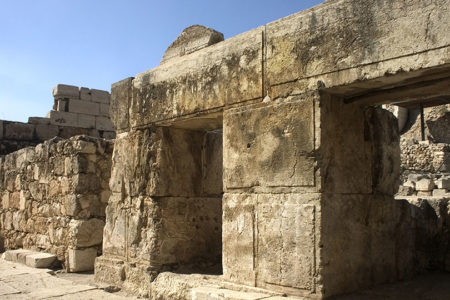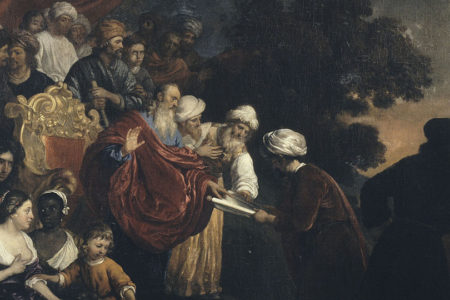Ezra and the Restoration Period
Ezra is much to be admired and emulated. And yet, for reasons understandable (but insufficient), he seems perpetually consigned to the “B-team” of Old Testament heroes. Although Ezra plays important roles in two Old Testament books, they are secondary positions. The book that bears his name and that he was used of God to pen is, in large part, history. Chapters 1 through 6 record the Jewish exiles’ return from Babylon under Zerubbabel and the building of the second Temple, events that transpired from around 538 B.C. to around 515 B.C., decades before Ezra was born.
Only the latter section is Ezra’s diary. Chapters 7 through 10 tell of the marvelous reformation in 458 B.C. under his direction. Again, Ezra is very much involved in the effort to refortify and repopulate Jerusalem around 445 B.C., as recorded in the book of Nehemiah (8:1–13; 12:26); but in that story he gets a bit lost behind the prevailing figure of the governor, Nehemiah.
The most important reason for such comparative neglect is that Ezra lived and ministered during the final stage of Old Testament history, which is little remembered by many Christians: the restoration period. During this era the Jewish people, captives in Babylon for 70 years, were allowed to return under the Persians to reestablish themselves in the Promised Land of Israel.
It is a fascinating time, punctuated throughout with remarkable heroes, exciting adventures, political and military struggles—everything that makes for gripping tales of noble human effort and thrilling divine enablement. But there is one element often associated with biblical narrative that is remarkably—and instructively—absent: miracle. The absence renders this period a bit disappointing and explains why it is often underappreciated.
When compared to the parting of the Red Sea or the tumbling down of the walls of Jericho or the floating of a lost ax head, the stories of the restoration period do not reduce themselves nearly so happily to a flannelgraph (if you get my point!). But it is against the backdrop of that reality that this period and the reformation narrative recorded in Ezra 7—10 must be understood and appreciated.
The Narrative
Briefly told, the narrative is this. Ezra is described as a priest and “skilled scribe in the Law of Moses” (Ezra 7:6, 11–12) who had “prepared his heart to seek the Law of the Lᴏʀᴅ, and to do it, and to teach statutes and ordinances in Israel” (7:10). About 60 years after the second Temple had been completed under Zerubbabel (chps. 1—6), Ezra was authorized and equipped by Persian King Artaxerxes to recruit as many as were anxious to return to the land of promise (including priests and Levites) and to attend to the worship being conducted at the Temple in Jerusalem in whatever way Ezra deemed proper (7:11–28). So Ezra prepared to make the trek from Babylon to Jerusalem, accompanied by approximately 1,700 pilgrims (8:1–20).
As the group set out, Ezra was chagrined to discover no Levitical priests had joined the pilgrimage (v. 15). He dispatched a nine-man delegation to a nearby city to recruit Levites (vv. 16–17). God blessed the effort, and two priestly families joined the pilgrims, as well as 220 Temple workers (vv. 18–20). Finally, before departing, Ezra proclaimed a fast (vv. 21–23).
The group faced a dilemma. As they set out on the long and dangerous journey, the Israelites considered the wisdom of asking the king for a military escort. But Ezra had assured the monarch they would be safe because “the hand of our God is upon all those for good who seek Him” (v. 22). So they determined to cast themselves upon God and trust Him; thus the solemn fast.
Ezra also appointed 12 leading priests and 12 leading Levites to care for the wealth being transported to repair and equip the Temple (vv. 24–30). It included 750 talents of silver (about 28 tons) and 100 talents of gold (about 3.75 tons).
The 1,000-mile journey across the Fertile Crescent went without incident, a fact Ezra attributed to God: “The hand of our God was upon us, and He delivered us from the hand of the enemy and from ambush along the road” (v. 31).
But when Ezra arrived in Jerusalem he was horrified to discover that many of the Jews who had returned earlier, especially the leaders, had embraced the wickedness of the pagan nations around them. In fact, many had taken pagan wives (9:1–2). Ezra was devastated; this was precisely the sin the nation had committed shortly after it first entered the land under Joshua (Ex. 34:15–16; Dt. 7:3–4). It was the sin that had plunged Israel into the dark ages known as the period of the judges (Jud. 3:6–7).
Ezra made his horror evident (Ezra 9:3–5) and then poured out his heart in a prayer of contrition and confession (vv. 6–15). His zeal impacted the city. Bold action was necessary; and at the suggestion of one of the citizens, Shechaniah, the decision was made to put away the pagan wives (10:1–8).
Courts were convened, justice and morality were honored, doubtless reparation was made, and difficult situations were resolved. Those who refused to submit to the Law were expelled from the community (vv. 9–17). This section of the record concludes with a catalog of those who submitted to the tribunal and thus contributed to the reformation and revival accomplished by God through Ezra (vv. 18–44). Ezra continued to live and minister in Jerusalem, and he played a pivotal role in Nehemiah’s work more than a decade later (Neh. 8; 12).
Instruction in Omission
Miracles are conspicuously absent in this narrative, yet there is instruction in that omission. Yahweh had made Himself King in Israel at Mt. Sinai in 1446 B.C. (Ex. 19—24), and He had reigned until 592 B.C. when the Glory-Cloud departed, as recorded in Ezekiel 11:22–23. That departure signaled the end of the theocratic arrangement.
During the remarkable time when King Yahweh resided in the Tabernacle/throne room in the person of the Glory-Cloud, He often intervened immediately—miraculously—in the affairs of His people. But with the Glory-Cloud’s departure, that theocratic arrangement was judicially abandoned.
This is not to say God abandoned His covenant with Israel; the covenant relationship is unilateral and thus eternally binding on God (Gen. 15:1–21; Heb. 6:13–18). Indeed, the theocratic arrangement had to do only with the form in which Yahweh’s relationship to that people was administered. The significance of the Glory-Cloud’s departure was not that Yahweh would no longer honor His covenant relationship with Israel and protect it from its enemies; it was that He would do so mediately rather than immediately, providentially rather than miraculously.
This is the grand message of the book of Esther. And it is a reality we see worked out in the most practical way in the restoration narrative recorded in the books of Ezra and Nehemiah. On those pages we watch as Israel learns what it is to live and honor God (however reluctantly) during the “times of the Gentiles” (Dan. 2; 7; Lk. 21:24) when God’s hand of protection is discerned only by the eye of faith—and a time that will endure until the stone cut out without hands (the Messiah) crushes the Gentile powers to powder (Dan. 2:44–45; Rev. 19:11–21).








Hello. Thank you for this lesson. Can you point me to a map that shows the likely path that Ezra took from Babylon to Jerusalem?